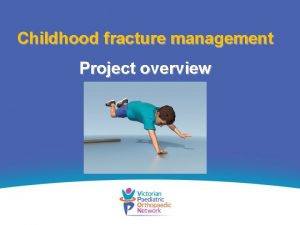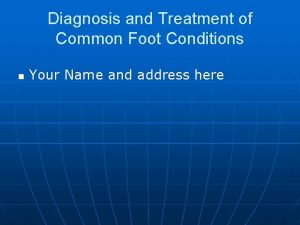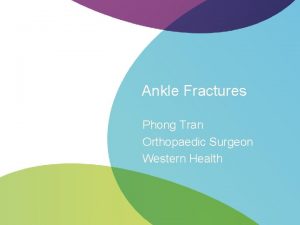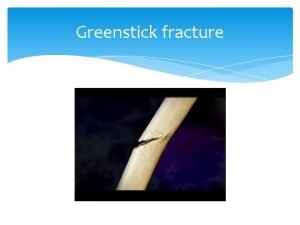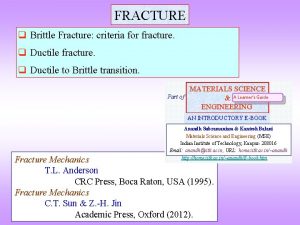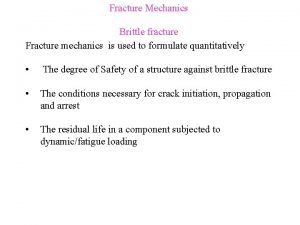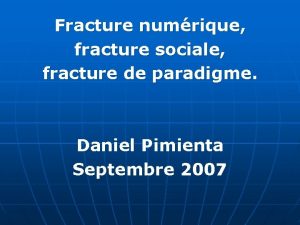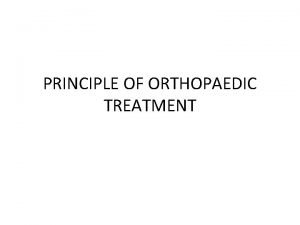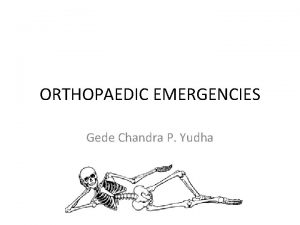Childhood fracture management Project overview Victorian Paediatric Orthopaedic














- Slides: 14

Childhood fracture management Project overview

Victorian Paediatric Orthopaedic Network

What this presentation covers § Project background § Guidelines § Education module § Implementing the guidelines

Background § Misdiagnosis is a common occurrence • Residents unable to determine if paediatric fracture present or not in 20% of cases (Ryan et al 2004) • Management incorrect in > 50% of cases (Ryan et al 2004) § Audit of plaster casts in a Victorian tertiary hospital – only 35% were deemed adequate

Background § Aim of project • Improve and standardise quality of paediatric fracture care § Developed by • ED physicians • Paediatric orthopaedic surgeons

Childhood fracture management RCH Clinical Practice Guidelines website www. rch. org. au/clinicalguide/fractures § Guidelines § Education module § Fact sheets § Casting videos

Clinical guidelines for ED § Easy to read format § X-rays to order § When to refer to ortho § Management in ED § Follow-up § Summary Radius/ulna shaft guidelines link

Education module § Bone anatomy § Fracture patterns § Principles of evaluation and management § Animations § Quiz Paediatric education module link

Family resources § Fact sheets • Clavicle • Buckle injury • Supracondylar • Wrist • Plaster care www. rch. org. au/clinicalguide/fractures/

Steps to implementing guidelines 1. Becoming motivated to change • Baseline audit • Raise awareness 2. Changing what needs to be changed • Identify barriers and tailor approach • Monitor progress 3. Making the change permanent • Sustain progress Source: Stroke and TIA care bundle. NICS 2009.

Barriers to uptake of guidelines Knowledge “I didn’t know there were guidelines” “I haven’t read the guidelines” Beliefs “It’s all good in theory, but practice is different” Behaviour “It takes time – time which I don’t have” “I know what’s best for my patients” Adapted from Cabana MD et al. JAMA 1999; 282: 1458 1465

Overcoming barriers Barrier Intervention Lack of knowledge • Raise awareness of guidelines (e. g. Poster) • Interactive educational meetings to highlight key messages Lack of motivation • Obtain patient feedback • Seek support from local opinion leaders • Include in resident/registrar performance review and orientation Source: Modified from How to change practice. NICE. Dec 2007

Overcoming barriers Barrier Intervention Beliefs • Seek peer influence & support from opinion leaders • Audit and feedback Skills • Run interactive education meetings • Incorporate into educational program Source: Modified from How to change practice. NICE. Dec 2007

Further information Michelle Vu Project Manager michelle. vu@rch. org. au
 Victorian paediatric orthopaedic network
Victorian paediatric orthopaedic network Charcot's joint
Charcot's joint Egyptians floral design
Egyptians floral design Egyptian floral design
Egyptian floral design Early childhood middle childhood
Early childhood middle childhood Brittle vs ductile fracture
Brittle vs ductile fracture Project management topics
Project management topics Orthopaedic surgery south east london
Orthopaedic surgery south east london Sally tennant orthopaedic
Sally tennant orthopaedic Peter worlock orthopaedic surgeon
Peter worlock orthopaedic surgeon Cappagh hospital hip replacement
Cappagh hospital hip replacement Stephen brennan bon secours
Stephen brennan bon secours Vbpm orthopaedic
Vbpm orthopaedic Professor abudu royal orthopaedic hospital
Professor abudu royal orthopaedic hospital Dime sign ankle
Dime sign ankle
